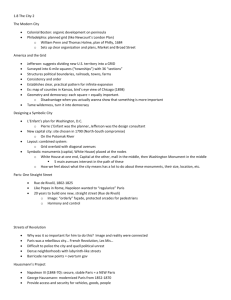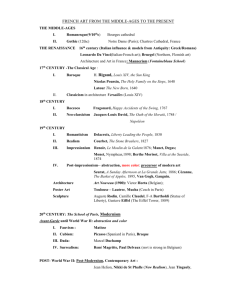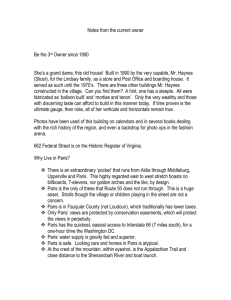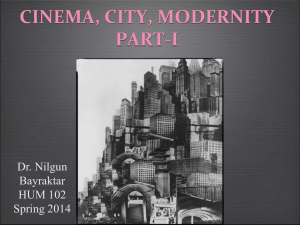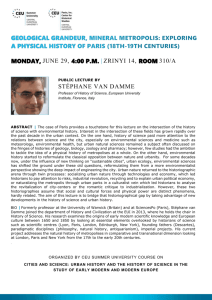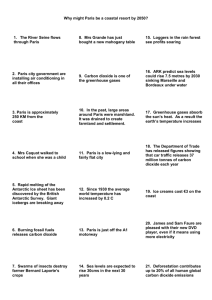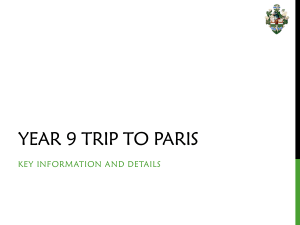regularization - lamp.tugraz.at
advertisement
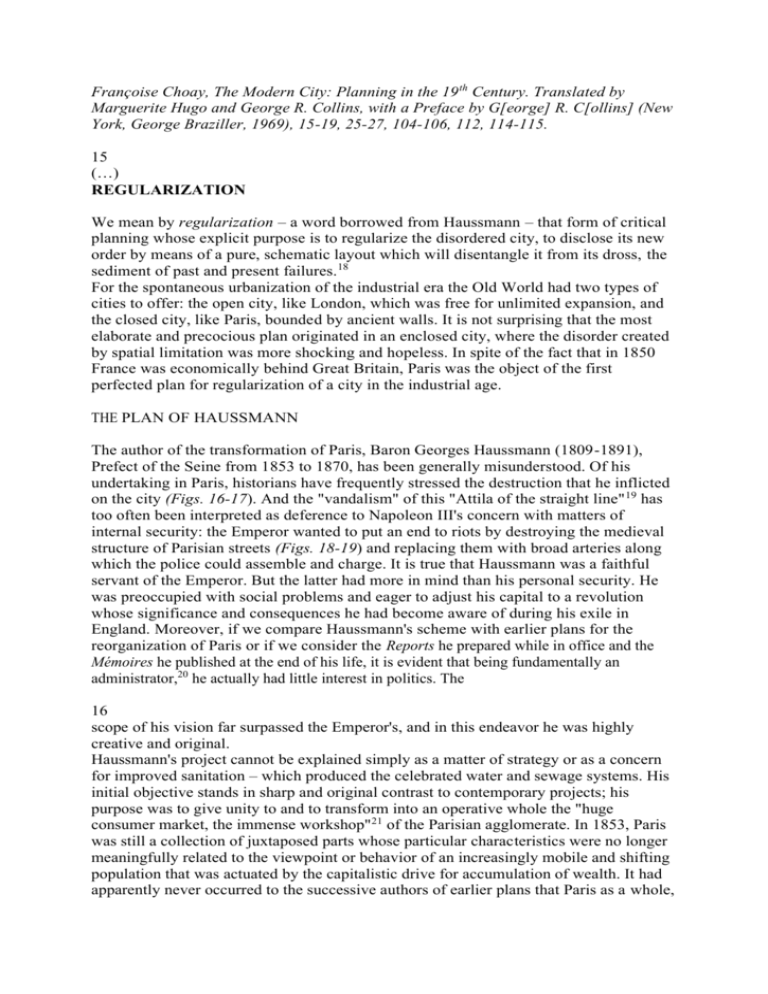
Françoise Choay, The Modern City: Planning in the 19 th Century. Translated by Marguerite Hugo and George R. Collins, with a Preface by G[eorge] R. C[ollins] (New York, George Braziller, 1969), 15-19, 25-27, 104-106, 112, 114-115. 15 (…) REGULARIZATION We mean by regularization – a word borrowed from Haussmann – that form of critical planning whose explicit purpose is to regularize the disordered city, to disclose its new order by means of a pure, schematic layout which will disentangle it from its dross, the sediment of past and present failures. 18 For the spontaneous urbanization of the industrial era the Old World had two types of cities to offer: the open city, like London, which was free for unlimited expansion, and the closed city, like Paris, bounded by ancient walls. It is not surprising that the most elaborate and precocious plan originated in an enclosed city, where the disorder created by spatial limitation was more shocking and hopeless. In spite of the fact that in 1850 France was economically behind Great Britain, Paris was the object of the first perfected plan for regularization of a city in the industrial age. THE PLAN OF HAUSSMANN The author of the transformation of Paris, Baron Georges Haussmann (1809-1891), Prefect of the Seine from 1853 to 1870, has been generally misunderstood. Of his undertaking in Paris, historians have frequently stressed the destruction that he inflicted on the city (Figs. 16-17). And the "vandalism" of this "Attila of the straight line" 19 has too often been interpreted as deference to Napoleon III's concern with matters of internal security: the Emperor wanted to put an end to riots by destroying the medieval structure of Parisian streets (Figs. 18-19) and replacing them with broad arteries along which the police could assemble and charge. It is true that Haussmann was a faithful servant of the Emperor. But the latter had more in mind than his personal security. He was preoccupied with social problems and eager to adjust his capital to a revolution whose significance and consequences he had become aware of during his exile in England. Moreover, if we compare Haussmann's scheme with earlier plans for the reorganization of Paris or if we consider the Reports he prepared while in office and the Mémoires he published at the end of his life, it is evident that being fundamentally an administrator,20 he actually had little interest in politics. The 16 scope of his vision far surpassed the Emperor's, and in this endeavor he was highly creative and original. Haussmann's project cannot be explained simply as a matter of strategy or as a concern for improved sanitation – which produced the celebrated water and sewage systems. His initial objective stands in sharp and original contrast to contemporary projects; his purpose was to give unity to and to transform into an operative whole the "huge consumer market, the immense workshop"21 of the Parisian agglomerate. In 1853, Paris was still a collection of juxtaposed parts whose particular characteristics were no longer meaningfully related to the viewpoint or behavior of an increasingly mobile and shifting population that was actuated by the capitalistic drive for accumulation of wealth. It had apparently never occurred to the successive authors of earlier plans that Paris as a whole, or simply the right or left banks, could one day become a single organism quickened with a unique life."22 Even when previous planning attempted to project far into the future, it remained fragmentary and governed above all by esthetic considerations. Analysis of the Artists' Plan, worked out in 1793 for the Convention, shows that planning was done by district (Fig. 20). It had essentially two aims: either the dividing up of property confiscated from the Church with a network of roads suitable for its further development or, whenever a monument seemed inviting, the creation around it of a formal system of radiating avenues. Thus, Saint Sulpice, the Observatory and the Val de Grâce constituted the Left Bank's three esthetic poles (Fig. 21). The Observatory, for example, gave rise to a starshaped Baroque project whose only justification was its perspective effects as it did not actually connect any significant centers of activity. Haussmann simply disregarded this and focused on a point farther north – the junctions of boulevards Port-Royal and Montparnasse with the boulevard Saint-Michel (Fig. 23). From his point of view the problem of the Left Bank was both one of unification – to be achieved by opening wide throughways running in both directions – and one of organic connection to the Right Bank. Consequently, he was to open (among others) the boulevard de Latour-Maubourg as a continuation of avenue d'Antin, the boulevard Saint-Germain as a line of connection between the two key districts of Etoile and Bastille, and boulevard Saint-Michel as a direct continuation of boulevard Sébastapol. The Artists' Plan (Fig. 20) and Haussmann's (Fig. 22) reflect two conceptions of the city. The first corresponds to the Paris of Balzac,23 with its various societies enclosed within their sep17 arate quarters, while Haussmann's is the Paris of Zola, a metropolis unified by the fever of capitalism. By and large, the now thoroughly familiar idea of the big city as a unified entity was still foreign to the mentality of Haussmann's period. In Great Britain, for example, the first official proposal for comprehensive treatment of the capital was not made until 1909, when John Burns introduced the Town Planning Bill. Haussmann's method of attack was as original as his task. All decisions had first to be supported by analysis of the existing situation. His "initial studies" (to use the Prefect's own expression) are evidence against the a-priori reasoning of which he has been accused. He examined his object of study in relation to two coordinates – time and space – and his first step on entering the Hôtel de Ville was to have drawn up a detailed and accurate plan of the whole city, the first of its kind. This year-long operation included a planimetric survey by triangulation as well as a topographical survey. 24 When the surveys were completed, he had the plan engraved on large sheets, to the scale of 5/1000 (Fig. 23). The sheets were mounted on canvas and juxtaposed on a frame on wheels, forming a screen which never left his office. Haussmann constantly studied the plan, which complemented his firsthand knowledge of the city that had previously been acquired by covering "every inch" of Paris "on foot." Haussmann's documentation was not static, however. The Prefect understood that a city, like any other organism, evolves in time, and that the view of the observer must therefore be at once prospective and retrospective, in order to safeguard its traditional dynamics as well as those orienting the future. How thoroughly he was acquainted with the capital's past may be judged from his summary of its history. It ranks for clarity with those of the best professional historians and enabled Haussmann to determine key zones and inert zones as well as those constants – the axes and poles – around which development occurs. Planning for the future would be facilitated by statistical data: like the present delegate of the Parisian District, Haussmann saw the future in terms of a population of millions of residents 25 and of economic needs increased millions of times. On the basis of his analysis, by what means did the Prefect propose to achieve the efficient working unity of the city? Primarily through designing a circulatory system and opening a system of ventilation. Problems of traffic flow were given priority. Haussmann's first step was to conceive a network of through streets which have no significance in themselves but 18 are essentially a means of connection (Fig. 21). They form new lines of communication, general ones between districts (east, west, north, south), specific ones between certain old or new key points such as railway stations or market places. Old streets were widened in order to accelerate traffic flow (rues Grenaté, La Reynie); blocked arteries were duplicated (rue Saint-Denis); and diagonals were cut (boulevard de Magenta, rue Turbigo). This overall network of arterial connections constituted what Haussmann described as a kind of "general circulatory system," which he subdivided into hierarchized tributary systems, each organized around a plaza, which is no longer a place in it itself but a traffic node, or what the Perfect termed nodes of relation. The enclosed plaza of the old order, a haven sheltered from traffic, has been suppressed. Haussmann's own description of his plan is breathtaking. He intends "to cut a cross, north to south and east to west, through the center of Paris, bringing the city's cardinal points into direct communication."26 The two axes, rue de Rivoli and boulevard Sébastapol with its extension boulevard Saint-Michel, will be completed by the double ring of outer boulevards (which include the continuation of those built under Louis XIV and a second ring), in order to provide a connecting framework within which will be incorporated the "system of the Etoile," the "system of the République," the "system of the Barrière d'Enfer," and so on.27 The same circulatory scheme will be applied for the new districts to the west, on the undeveloped sites of the old suburban villages of Auteuil or Passy. The originality of Haussmann's conception can be gauged by the degree of opposition he encountered – both from the Emperor and from the Chamber of Deputies – and by the difficulties he met with at the time of the 1858 Treaty when he attempted to impose his logic of comprehensive planning. The second important idea behind Haussmann's planning was sanitation through the creation of voids – that is, through systematic recourse to a kind of surgery which has since been considered vandalism. Never before, for sure, had such wide-scale demolition been carried out, never at least in terms of solids and voids. With Haussmann, the notion of open space (Freiflach), still current today, came into being – open spaces which are not laid out for visual or ceremonial effect as in the Baroque, but simply for the negative reason that they are not to be filled in. And related to this idea of open spaces was that of verdured space which is very different from the old public garden in that it has lost its semiotic richness. Demolition was badly needed, however. Today we find it 19 difficult to imagine the cramped, unsanitary conditions existing behind facades which, due to the newly born sense of history, the contemporary bourgeoisie had begun to find to be picturesque. Also, we have forgotten the vast number of structures which had progressively invaded all the city's open areas; some had even crept into the courtyard of the Louvre. Haussmann undeniably caused devastation, though nothing to compare with that wrought by the French Revolution. For since that time the archaeological vision had been born, and it forced the Prefect to spare monuments of the past.28 But in the 1850's and 1860's, the idea of preserving an urban texture had not yet matured: Haussmann's most serious error was to destroy irrevocably the tightly woven and diversified fabric of the Île de la Cité, whose new blocks of giant buildings condemned it to death (Fig. 19). Nonetheless, Haussmann's surgery had its positive side. Within the network of streets designed for traffic flow, he created a hierarchy of planted areas, which he divided into four categories: promenades like the Champs-Elysées; squares, the model of which Napoleon III had brought back from London; public gardens laid out in a romantic pattern (the most successful of these are the Montsouris and Buttes-Chaumont parks [Fig. 24]); and lastly, suburban parks situated at the eastern and western limits of Paris. In the latter, formerly royal forests, right-angled paths and star circles intended for the royal hunts in the seventeenth century were replaced by curved roads encircling artificial lakes. In his Mémoires, Haussmann constantly brings up esthetic matters. But this aspect of his work is not original and can be summed up as a monotonous repetition of the principles of Neoclassicism: uniform frontage lines along broad, straight streets, research into perspective effects and location of monuments on a perspective axis. For Haussmann, esthetics are actually secondary, coming as a belated attempt to embellish streets which he had not originally laid out for reasons of beauty. Although indifferent in this respect, his work did not fail to impress some of his contemporaries as evidenced by Vienna and Berlin. But the real basis as well as the originality of his planning lies in the dual concept of a circulatory and respiratory system. This schema of regularization emerges during the last third of the nineteenth century as the fundamental verity of the capitalist-industrialist order. It will be referred to as the Haussmann pattern though it sometimes developed empirically outside the sphere of Parisian influence. For Paris offers the most systematic example of its application and served as a model for the majority of the other cities. 20 (…) 25 (…) COMMENTARIES AND METALANGUAGE Urbanists in charge of regularization not only drafted projects but also discussed them in an abundant literature that included their comments and theories. The nineteenth century is the century of criticism: in the case of city planning, there is a definite correlation between the semantic impoverishment of the urban system itself, and the appearance of theoretical treatises preceding and justifying various practical proposals. It is in these 26 texts that one can directly appraise the mutation by which city planning acquired a critical dimension. Haussmann's principles and his Mémoires (a justification by hindsight, which in fact returns to the a-priori arguments of his decrees and speeches as Prefect) are echoed both by Paxton's testimony, The Evidence,35 and by the didactic writings of German architects like Stübben. But the most astonishing written work we unquestionably owe to Cerdà. In the first volume (eight hundred pages) of the Teoria General de Urbanización (1867),36 written at the same time as the Mémoires and twenty-three years before Stübben's Der Städtebau, all the themes of the new literature are collected, related, and set forth in detail: namely, historical perspective as applied to urban history; research into a taxonomy of not only cities and planning methods but also of urban elements (traffic arteries, streets and plazas, housing, gardens and so on), which must be based on historical evolution as well as functional analysis; a priority of traffic problems in any planning for the present or future. In Cerdà's work, this semantic priority given to urban circulation is symbolized by the fact that this function is the basis of his classification of cities, the criterion by which the various phases of urban history are put in chronological order: The structure of the most ancient cities is adapted to pedestrian circulation (locomociòn pedestre); later it is transformed to fit, successively, horseback (locomociòn ecuestre), an intermediate stage of dragged sledges (rastrera), and finally the wheeled vehicle (rodada). The latter is in turn divided into ordinary (horse power) and perfected (perfeccionada), which used the steam engine and had just been worked out in Cerdà's time. 37 A distinction is thus made between the traditional and the improved rodada which is contemporary with ciencia urbanizadora (urban science). One must also notice the importance given by the Spanish engineer to the philology upon which he grounds his theories. Through etymological analysis he was better able to penetrate the meaning of terms that are traditionally employed to designate what is urban, and further to justify the invention of a new expression – una palabra nueva – for use in the new planning. The language of planning, which came out of critical analysis, is a scientific language, destined by its very nature to become the attribute of a planning establishment – in other words, a metalanguage38 – though Cerdà himself never claimed this and no doubt was unaware of it. If we analyze the actual accomplishments of regularization as well as its projects and metalanguages, we may define the process as follows: 27 1) The city is conceived as an object: Both theoretically and in its reality, the modern city came out of the same type of reflective effort that produced the nineteenth-century concepts of art and labor. The city-exhibitions first held in Germany at the beginning of the twentieth century were the symbol of this reification – literally an incarnation of nineteenth-century theory. As a consequence of this process and of the century's general awareness of history, the concepts of historical monument and preservation of the past were created. The nineteenth century is the first to be concerned with the conservation of the past as a whole. The leader in this respect was France (in 1837 the Commission des Monuments Historiques was created),39 but her measures of conservation were directed at isolated edifices and not at urban ensembles. 2) An analytical method is used, both in the study of the object and in the elaboration of projects. The key words are classification and system. Its use of classification, in which visual factors were extremely important, appears to have been borrowed from the natural sciences. Moreover, the concept of function evolved by the new biology becomes the basis of the systems created by the city planners who also apply to the city biological images like circulation, nucleus, and cell. 3) Two objectives are given exclusive priority: traffic and hygiene. (…) 102 (…) PRE-URBANISM AND URBANISM: THE CULTURALIST MODEL (…) 104 (…) URBANISM – CAMILLO SITTE It is Camillo Sitte (1843-1903) who makes the transition from pre-urbanism to urbanism in the culturalist model. In his book, Der Städte-Bau nach seinen künstlerischen Grundsätzen, he gives the culturalist model a more complex and precise structure which will eventually lead to its practical application. Sitte, director of the State School of Industrial Arts in Vienna since 1883 and also an erudite professor of art history, remains primarily an architect. He posesses the technical skill that both Ruskin and Morris lacked, but is devoid of the political social involvement that motivated their work. Esthetics are his guiding principle. Sitte's book has its origin in the contemporary attempts at modernizing Vienna, and in particular, construction of the Ring, which was taking place practically before his eyes and offered an example of what not to do. In order to indicate the right directions, he elaborated a model of spatial organization based on systematic analysis – "in a purely artistic and technical manner," of the "compositional elements" which came into play in the preindustrial city and evolved from an innate, instinctive aesthetic sense.” 66 Pencil in hand and working from books, but more often in situ during the course of frequent travels, Sitte dissected classical, medieval, and baroque spatial organization. In all three types, one can find the same fundamentals which are inherent in the connection of their elements. Space is continuous, and buildings have meaning only insofar as they are related to each other; for Sitte “the modern disease of isolated con105 struction" is to be condemned and monuments are actually to be built into the urban fabric: on ancient European plazas, for example, churches were seldom entirely disengaged from adjacent buildings on more than one side (Figs. 71-72). Hence, also, the importance and value given to connecting elements such as plazas and streets which modern planning can conceive of only in terms of voids: "Plazas used to form a whole with their surrounding buildings," wrote Sitte. "… in the Middle Ages and the Renaissance there still existed a vital and functional use of the town square for community life and also, in connection with this, a rapport between square and surrounding public buildings. Meanwhile in our day plazas are, at most, used as parking lots."67 What is more, to function effectively, urban space should be enclosed. "… The main requirement for a plaza, as for a room, is the enclosed character of its space." 68 Enclosure is also considered by Sitte as essential to a feeling of well-being. Analysis shows that access streets leading off like turbine blades contribute to the closed-in feeling that is characteristic of ancient plazas. In this spirit, the Viennese planner considers areas of greenery to be like plazas, carefully circumscribing them with buildings in order to keep them from losing their urban character. In the distribution of solids and voids, the only criteria should be irregularity, imagination, and asymmetry. This is to condemn the straight line, regularity, and symmetry which have led modern planners to place statues and fountains at the center of a plaza and not, as in the past, along its edge. The first practical instance to which Sitte applies his analysis is in connection with a project for the Ring69 (Fig. 73). In the area of the Votive Church, for example, Sitte confronts the problem of an inert, ununified space in which disparate edifices (church, university and a chemical laboratory) stand out as isolated units (Fig. 74). He chooses to interconnect them by means of a series of arcades and new construction adjoining the church which will partition the area. Thus he obtains two new plazas and achieves limited vistas to avoid the former feeling of vacuousness; he attains intimate enclosures, human scale and a surprisingly rich network of walkways. Hence the main features of the Sittesque spatial model are continuity in constructed elements, enclosure, diversity, asymmetry, irregularity, and connecting elements which are significant in themselves. Sitte for the first time radically challenges a-priori abstract city planning which comes off the drafting board, and points out its failure to take concrete experience into account. Thus he stresses the existential value of space and defines what might be called a behavioral space (Fig. 75). No wonder that Aristotle's word security appears on the first page 106 of his book; his investigation into esthetic value in city planning should not be confused with the numerous contemporary tendencies toward two-dimensional pictorial effects. The limitations of Sittesque planning arise, nonetheless, from the exclusive importance accorded the esthetic dimension, even when it is extended to include physical and psychological well-being. In his project for the Ring, for example, Sitte designs buildings and elaborates forms primarily for the purpose of arranging space and scarcely considers their meaning or their intended use. This purely esthetic approach became as monosemantical as the economically determined planning of Haussmann. Sitte's model misses the fundamental destination of the modern city and ignores its complexity; it applies only to neighborhoods, on the level of the everyday activity of the pedestrian. This explains, in fact, why it was used mainly in plans for suburban areas and for city extension. In this connection, as soon as his book was published Sitte's ideas were immediately and enthusiastically adopted in Germanic countries, where, as the Collinses have pointed out, they appealed to a latent nationalism and began to undermine the prevalent Haussmann-type planning. Following the publication of his book, several municipalities (Altona, Brünn, Linz, Olmütz) were to request Sitte or his collaborators as urbanist. The most important achievements based on Sittesque planning are by Karl Henrici (1842-1922) (Fig. 76), who planned the extension of Dessau (1890) and of Munich (1893); Theodor Fischer (1862-1938), the Chief Town Planner in Munich from 1893 on; Theodor Goecke (1850-1919), Otto Lasne (18541935), and Friedrich Puetzer (1871-1922) who worked in Darmstadt,70 Wiesbaden, Mainz. In Great Britain, Sitte exerted a strong influence, though not until the beginning of the twentieth century, when his cause was taken up by Patrick Geddes and Sir Raymond Unwin. On the other hand, in French-speaking countries where his book was translated in 1902, Sitte was almost completely ignored.71 After World War I, the situation was aggravated by Le Corbusier when he stigmatized the Austrian planner as an apologist "for the donkey's way" and a "passé au petit pied." Outside the specific realm of urban planning, Sitte's theories also apply to the conservation of old cities. Thanks to Sitte and his contemporary, Burgomaster Charles Buls (1837-1914), who was responsible for the restoration of the Grande Place in Brussels, a new objective was formulated: the preservation of an urban ensemble and its fabric.72 111 NOTES (…) 112 (…) 18 Haussmann's use of the expression "régulariser" is to be found in his Memoires (Paris: V. Havard, 1890-1893), Vol. III, pp. 67, 91, with regard to the parts of old Paris where he was establishing his new circulation system. 19 "Attila of the straight line" is to be found in Victor Fournel, Paris nouveau et Paris futur (Paris: Lecoffre, 1865), p. 220. 20 When offered the high position of Préfet de Police by the Emperor's envoy in 1851, Haussmann, then Préfet de Gironde, refused: "never in my life was I involved either in politics or even more in police affairs, unless duty bound. On the other hand, I have a deep relish for administration per se; it is my vocation." (Haussmann, op cit., II, p. 8.) 21 The expressions appear in Mémoires, II, p. 200, excerpted by Haussmann from a speech of 1864. 22 Maurice Halbwachs, "Les plans d'extension et d'aménagement de Paris avant Ie XIXième siecle," in La vie urbaine (1920), p. 25. 23 The entire series of Balzac's Comédie humaine was published between 1830 and 1847 (Le cousin Pons), whereas Zola developed his Rougon-Macquarts cycle from 1871-1892. English industrial novels corresponding to Zola's phase are much earlier: Mary Barton was published in 1848, Hard Times in 1854. 24 In order, for instance, to avoid costly mistakes like the opening of the rue des Ecoles as had been ordered by Napoleon III. 25 Haussmann, op. cit., III, pp. 424-425. 26 Ibid., p. 50. 27 Ibid., pp. 70, 90. 28 "It is presently the fashion among a group of archaeologists to admire without restraint the old Paris which they certainly never knew except through specialized books and collections of drawings….. They complain about the shameless stir of Baron Haussmann…. But they simply ignore the fact that the narrow winding streets of the center were practically impenetrable to traffic – dirty, stinking, and unhealthy…. Do show me a single monument, one artistic building which my administration destroyed (and did not help) to isolate." (Ibid., p. 28.) (…) 113 (…) 35 Report from the Select Committee on Metropolitan Communications. Session 1854-55. Evidence of Sir Joseph Paxton, p. 79, Qu 716 (7 June 1855). 36 The reading of this volume (which has not yet been translated) is, in spite of its length, fascinating. The equally large second volume contains only statistical data. The most recent study of Cerdà is by Arturo Soria y Puig in Hogar y Arquitectura (Madrid), No. 69, 1967, pp. 65ff. 37 See Vol. I, Book 4, Chap. 1, entitled "De la formación de las urbes, considerada bajo el punto de vista de las necessidades de cada época, de conformidad con los medios de locomoción de que en cada una de estas ha podido disponer el hombre." In the opening pages of his book, Cerdà gives a lively d escription of his emotion and wonder when he saw one of the first trains: he immediately sensed their importance for city planning. 38 Barthes' definition of metalanguage: "a system in which the content (as opposed to the expression) is itself formed by a system of meaning; in other words it is a semiotical system dealing with a semiotical system." ("Eléments de sémiologie" in Communications 4 [Paris: Le Seuil, 1964], p. 130.) I.e., metalanguage is used when one discusses language itself. Compare with Cerdà's inventions the addiction of Patrick Geddes to coining new words such as megalopolis, patholopolis, necropolis, politogenics, politopathy, paleo- and neo-technical, conurbation, many of which have been adopted. 39 Note in particular the part played by Prosper Mérimée (1803-1870), who was nominated Inspecteur Général des monuments historiques in 1841. (…) 114 (…) 66 Camillo Sitte, City Planning According to Artistic Principles, translated by George R. Collins and Christiane Crasemann Collins (New York: Random House, 1965), pp. 4, 20. 115 67 Ibid., p. 16. 68 Ibid., p. 32. 69 Sitte explains his scheme in ibid., chap. XII, "Example of an Urban Arrangement According to Artistic Principles." 70 For this residential suburb in Darmstadt see George R. and C. C. Collins, Camillo Sitte and the Birth of Modern City Planning (New York: Random House, 1965), fig. 16. 71 The Collinses showed how misleading C. Martin's translation was – chapter 7 was added entirely by the translator. Such alterations were even more damaging because, having no English version at their disposal, non-German architects and planners tended to read Sitte in the truncated French version. 72 See Charles Buls, Esthétique des Villes (Brussels: Buylant-Christophe, 1893) and "La conservation du coeur des anciennes villes," Tekhne (Brussels, 1912), nos. 64-66. In his Preface to Esthétique, Buls regrets the French deficiency in that field, and praises the German researches which, he says, were already numerous in 1860. He quotes in particular the names of Visschers, Botticher, Schnase, Lübke, Semper. At about the same time, Buls translated into French the first and up to now the only sample of Stübben's writings, a report to the International Engineering Conference in Chicago (1893), under the title: "La construction des villes. Règles pratiques et esthétiques à suivre pour I'élaboration des plans de villes" (Brussels: Lyon-Claesen, 1895). At the time of Esthétique, he seems to have been totally unaware of Sitte and his Städte-Bau. (…)
